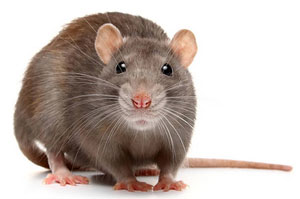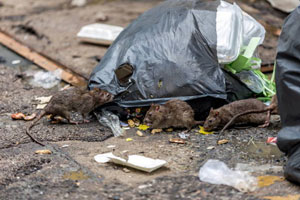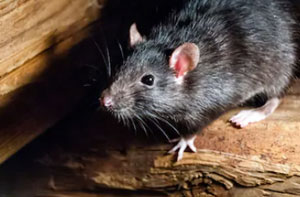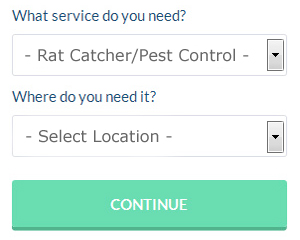Rye Rat Catchers (TN31): Noticing rats in your house or garden can be quite a shocking experience to go through even though it is not so frequent an occurrence in Rye these days, it is definitely something that happens. Rats tend to breed quickly and are likely to cause problems, particularly when there are a lot of them. A single sighting of a solitary rat won't be that much of a problem, but if you are noticing them on a regular basis make sure you do something about it.
If you see rats in Rye, the probabilities are that they'll be brown rats (Rattus Norvegicus), even though there are actually 2 sorts of rat presently found in Great Britain; black (or ship) rats and brown (common) rats. As you may perhaps know ship rats were responsible for the Great Plague (17th C) at which time they were quite widespread. Black rats are relatively scarce nowadays and actually neither type is a native of the United Kingdom, both of them coming from Asia.

The black rat at 5" to 7" long, is smaller than the common brown rat, which reaches a length of up to about 9" and weighs in at around 500g. To prevent their incisor teeth from growing too long, common brown rats must keep on gnawing at stuff, which explains why they cause so much damage and destruction. Rats particularly love to gnaw at woodwork.
Rats transmit diseases, leave droppings, gnaw through wires, pipes, woodwork and insulation, and are typically problematic in homes and business premises in Rye. Property holders ought to report incidences of rats to the local authorities. You could also report sightings of rats and other pests on the .gov website online HERE.

You'll sometimes discover the existence of rats not by in fact physically observing them, but by them indicating their activity in other ways. It is possible you could observe distinctive rat holes gnawed into floorboards or skirtings, you may hear noises coming from a loft, wall or floor, you could find droppings on floor surfaces or in cupboards or you might come across a rat's nest hidden away somewhere.
If you do not want to wait for the local environmental health authority to take care of your problem it's also possible to bring in local Rye rat catcher or pest controller who'll be qualified in the art of pest removal. In the world today rat catchers commonly fall into the category of pest management, and pest elimination experts don't only control rats but additionally fleas, bedbugs, cockroaches, mice, moles, wasps and all manner of garden and domestic pests. (Tags: Rat Catcher Rye, Pest Control Rye )
Rat Traps Rye: Whether you're likely to deal with the rat situation yourself or if you are bringing in professional rat catchers, one way to achieve this is by using rat traps. These days there are many different types of rat traps readily available, supplying you with a range of capture solutions. Should you be opposed to the harming of animals, perhaps the capture trap are the best answer. Rat traps can be found in all shapes and sizes and include the likes of: cage traps, electronic rat traps, spring loaded bait traps and enclosed poison traps.
Pest control and rat catching can be done in Rye and also in: Brookland, Icklesham, Rye Foreign, East Guldeford, Beckley, Udimore, Peasmarsh, Brede, Pett, Camber, Broad Oak, Iden, Winchelsea, Playden, together with these postcodes TN31 7NX, TN31 7BY, TN31 6WE, TN31 7NB, TN31 7LY, TN31 7JS, TN31 6XZ, TN31 7HW, TN31 7EL, and TN31 7HP. Local Rye rat catchers will most likely have the telephone code 01797 and the postcode TN31.
Rye Mole Catching: Whilst not such a common pest these days moles are occasionally controlled by rat catchers. Bringing about completely different issues to rats, moles are certainly not quite so despised. The chief problem with moles is that they'll cause damage to your garden, especially to a lawn. The familiar sight of mounds of earth in the middle of a nicely manicured lawn is the evidence of mole activity. The preferred and humane strategy to remove moles is by using traps.
Types of Rat
In Rye or anywhere else in Great Britain, there's only 2 sorts of rat which you are going to run into. The Brown Rat (Rattus Norvegicus) and the Black Rat (Rattus Rattus).
The Brown Rat (Rattus Norvegicus):
In Rye, the rest of the UK and Continental Europe the most prevalent species of rat is the brown rat (common rat, sewer rat, street rat or Norwegian Rat (Rattus Norvegicus)), this is the one you will sometimes spot in your garden or house. The colour of this rodent varies between grey and brown, it typically grows to around 4 to 9 inches (with an equivalent length tail) with a weight range of between 140 and 500g. It was given the name Norway Rat (Rattus Norvegicus) as it was believed to have come to the United Kingdom by boat from Norway. It is nowadays considered to have originated from China or Central Asia. Brown rats have excellent hearing but poor eyesight, they dig a lot and climb well, they're omnivores but have a preference for grain cereals, the female rats may produce five litters of up to 14 pups each year.
The Black Rat (Rattus Rattus):
Also not native to the British Isles, the black rat, roof rat or ship rat (Rattus Rattus) first came to Europe from Southeast Asia (most likely India). Understood to have been spread in Roman times, this rat very likely reached Europe and the UK inside spice shipments. The black rat was once widespread in Great Britain however was essentially driven out by the brown rat and is now not often seen. The black rat attains a length of 5" to 7" and weighs about 75-230 grammes. Black rats have a reputation for spreading a variety of diseases, in particular listeria, bubonic plague, trichinosis, salmonella, toxoplasmosis, typhus, tularemia, rat bite fever and Weil's disease.
Checking for Rats: If you have an inkling you might have rats in your property or business, there are various ways by which you could tell. You should check for gnaw marks in cables, wood and wires, particularly in lofts, be on the lookout for tunnels or burrows adjacent to solid surfaces, listen for continual scratching noises emanating from walls and lofts, particularly during the night, keep your eyes open for rat droppings, they are dark brown and look like large grains of rice, hunt for signs of footprints or tail trails on loose soil or in dusty areas, watch out for rub marks on walls and skirting boards where greasy fur has left marks.
Rat Burrows: One thing that all rats love to do is dig and burrow, and the area where they most like to do it is next to solid objects or structures such as walkways, garages, garden shed bases and patios. Rats build extensive networks of burrows which provide shelter, food storage and nesting. The entrances to rat burrows are normally worn smooth by the continuous ins and outs, so keep an eye out for holes with smooth sides at the side of solid structures. The entrances to burrows are generally about 2-4 inches across. Chuck some debris into the burrow entrance and check the following day to determine if it has been moved. This should clarify if rats are still in situ.
What Attracts Mice and Rats?
While some people in Rye might think that they are cute with their fur covered bodies, pointy faces and twitching whiskers, rats and mice are certainly not creatures that you want to have living in your home or garden, and they can actually be dangerous to have around. By nibbling through insulation materials, electric wires, plastic and wood, mice and rats can cause accidents and in particular electrical fires. Spreading conditions like listeria, bubonic plague, trichinosis, salmonella, toxoplasmosis, typhus, tularemia, rat bite fever and Weil's disease, rats and mice can cause more than thirty sorts of disease. Among the things that will certainly attract rats and mice to your home or garden are:
- ENTRY POINTS AND HOLES - Rats and mice can squeeze through the tiniest of cracks and holes, so watch out for spaces around entrances, crawl spaces, piping and air vents.
- PET WASTE/COMPOST - Remarkably compost heaps and even pet waste can attract rats and mice - they'll find a few tasty morsels hidden in there!
- TRASH/RUBBISH - Accumulations of garbage and garden waste piled up on your property (particularly in the garden) will obviously attract mice and rats.
- CLUTTER - General clutter in an outbuilding, basement or attic will be especially attractive to mice and rats, especially if there is a source of food nearby.
- WATER - Rats and mice have to drink, so sources of water such as seeping sprinkler systems, birdbaths, leaky pipes and pet water bowls are a big attraction for these unwelcome pests.
- FOOD - Food that is left lying around or discarded is perhaps the main attraction for mice and rats.
General Pest Control in Rye
Pest control is a crucial service that covers a whole host of preventive and remedial measures to manage and eradicate common pests in commercial, public and domestic spaces in Rye. The health, comfort and safety of individuals, property, and overall well-being of local communities are all crucially dependent on it.
"General pest control" is the term used to refer to the management and control of various pests that can infest public areas, businesses and homes. Such pests include a diverse range, including bedbugs, insects like ants, cockroaches and rodents like mice and rats, and other annoying pests such as spiders, silverfish and flies.
Preventing infestations before they happen is a primary goal of pest control. Maintaining cleanliness, pest-proofing and regular inspections are preemptive measures that achieve this. Identifying potential entry points and addressing conditions that attract pests, such as food debris or water sources, is a key strategy for business owners and householders in Rye to significantly reduce the risk of pest issues.
Effective and prompt pest control services are essential for addressing the issue of pest infiltration. Pest control professionals can effectively identify the specific pest species, assess the extent of the infestation, and develop a bespoke eradication method. Pest elimination is achieved through a variety of methods and techniques, such as trapping, baiting, exclusion measures and insecticide applications.
Moreover, general pest control encompasses the humane capture and rehoming of wildlife, such as bats, squirrels and birds, which can infiltrate properties and pose health and safety issues. In a concerted effort to protect both human and animal well-being, pest control professionals employ eco-friendly and ethical methods to ensure the safe relocation of wildlife to their natural habitats, minimising the risk of harm.
Employed frequently in general pest control, Integrated Pest Management (IPM) represents a sustainable and environmentally responsible approach. IPM places a high priority on employing non-chemical methods, such as sealing entry points, implementing sanitation measures, and using biological controls like natural predators whenever they are viable options. In compliance with regulations, chemical treatments are used cautiously to minimise their impact on both non-target species and the environment. (88442 - General Pest Control Rye)

Homeowners with rat problems in Rye are often tempted to have a go at solving it for themselves. So, if you find yourself in this situation, what should you do? There are a host of products currently available to help you accomplish this and you'll find rat traps, rat poisons and other similar products in hardware stores, supermarkets and shops in and around Rye. Nonetheless, unless you're aware of what you're at, it is possibly far better to appoint an experienced rat exterminator, who'll have handled this issue hundreds of times previously, and will automatically know what the best solution is. The rookie's use of rat poison is likely to do more harm than good, seeing that you have to be exceptionally vigilant with them especially when pets and children are about. If you know what's better for you, always bring in a specialist rat control service in Rye for a solution to your rat problems. (Tags: Rat Control Rye, Rat Exterminators Rye, Rat Removal Rye)
Pest Control Services Rye
Rye rat catchers will likely help you with preventive pest control, electronic pest control, mouse control, the installation of pheromone stations, bird dropping clearing, rat poison, wasp pest control, bed bug heat treatments in Rye, bird pest control, household pest control in Rye, pest extermination, mole catching, residential pest control, mouse pest control, rat removal, the control of pests, rat proofing, rat prevention, pest removal, squirrel control, restaurant pest control, powder treatments, ant pest control, rodent control in Rye, fogging & spray treatments in Rye, rat infestations, pest netting, wildlife management, rat pest control, pest control in Rye and other pest control in Rye. Listed are just an example of the tasks that are handled by people specialising in pest control. Rye providers will keep you informed about their full range of services.
Pest Control Nearby
Also find: Rye Foreign rat catchers, Broad Oak rat catchers, Playden rat catchers, East Guldeford rat catchers, Winchelsea rat catchers, Peasmarsh rat catchers, Beckley rat catchers, Camber rat catchers, Brookland rat catchers, Brede rat catchers, Iden rat catchers, Udimore rat catchers, Pett rat catchers, Icklesham rat catchers and more. These and other communities and towns are catered for by rat catchers and comparable experts. These professional pest controllers, with their wealth of expertise and knowledge, ensure efficient and effective resolution of your rodent issue. The skills and resources necessary to swiftly resolve a rat problem, whether it involves just one or a larger infestation, are readily available with these pest control specialists. By simply clicking here, pest control quotes are readily accessible to local property owners.
Rye Rat Control Services
- Rye Rat Deterrent
- Rye Mouse Control
- Rye Rat Extermination
- Rye Rat Inspections
- Rye Mole Catchers
- Rye Rat Trapping
- Rye Pest Inspections
- Rye Domestic Pest Control
- Rye Pest Control
- Rye Rat Catching
- Rye Pest Removal
- Rye Rat Catchers
- Rye Rodent Control
- Rye Rat Prevention
More: Rat Extermination, Pest Management, Rat Extermination, Rat Catching, Rodent Control, Cheap Rat Catchers, Pest Management, Commercial Rat Control, Pest Removal, Rat Catchers, Rat Control, Residential Rat Control, Cheap Rat Catchers, Cheap Rat Removal, Rat Prevention, Rodent Control, Cheap Pest Control, Rat Extermination, Mouse Control, Cheap Rat Catchers, Rat Specialists, Rodent Control, Pest Control, Rat Extermination, Rat Specialists, Rat Catchers, Mouse Control, Domestic Rat Control, Rat Specialists, Pest Removal, Same Day Pest Control, Pest Inspections, Pest Management, Pest Control Surveys, Pest Control Specialists.
Rat catchers in TN31 area.





